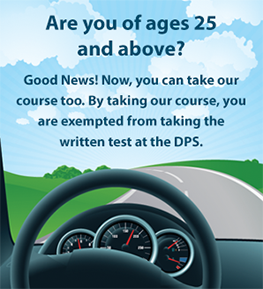

One of the hardest things to do is drive in adverse weather conditions and the rainy weather makes it incredibly difficult for the tires to grip the road. Therefore, it is important that young drivers today learn how to drive in the rain, because according to the statistics released by the US Department of Transportation and the Federal Highway Administration showcase that there are 6,400,000 automobile accidents that occur in the United States on average and 24% of these crashes which amount to 1,536,000 road accidents caused by bad weather conditions. The resulting injuries and deaths from these accidents equate to 673,000 injuries and 7,400 deaths annually. Furthermore, the vast majority of these accidents occurred when there was heavy rainfall and driving conditions were less than suitable.

Keep Both Your Hands Firmly on the Steering Wheel
People today have gotten into bad habits while driving, some talk on the phone, others eat; get distracted by the radio and even texting! Driving while keeping one hand off the steering wheel has become normal for drivers today, this certainly hasn’t helped them avoid getting into accidents. You should keep your focus and pay even more attention when it is raining, which is why we advise you to keep both hands firmly on the steering wheel at all times when driving in the rain, since that lessons the chances of your car spinning out of control.
Keep Your Headlights Switched On At All Times!
When you are driving in the rain, your vision may be impaired slightly, particularly if it raining quite profusely. This can cause to not see other cars on the road that are driving near or beside you. This is why it is a wise choice to keep your headlights switched on at all times, since it helps in improving your visibility and helping you lessen the chances of creating or getting into an accident.
Keep Your Distance from the Car In Front!
When driving in the rain, you should maintain as much distance as you can from the car in front of you, since you can never take the chance of what might happen should the car in front suddenly brake or lose control in the rain. As taught in most driving safety courses, The road conditions are not perfect and a car normally skids when the brakes are applied on a wet surface, so leave room for some error.
Driving in the rain is definitely not easy but the above mentioned tips can help you avoid getting into an unnecessary accident that may cost you heavily.
Driving is a fairly complicated task in every terrain. You are using more than one body part simultaneously and the way one is being used is directly dependent on the other. Your eyes are the primary guiding force that supervises the movement of your car. Even though it sounds simple and implied, there is a lot more to this story.
It is your field of vision that plays an important role in preventing accidents and helping you make decisions in a timely fashion. However, speeds can reduce your field of vision significantly thereby increasing the chance of accidents. The night time case is even more dangerous than the day time. To find out more about this phenomenon, read through here carefully and make your driving decisions wisely.
So What Do You Mean By the Field of Vision?
The field of vision signifies your ability to look into your periphery without moving your head. When you are standing stationary, you experience the highest field of vision in the horizontal pane as well as in the vertical. Roughly, it is estimated that your horizontal vision spans over 180° and 130° in the vertical axis along your line of sight. So you can look straight ahead and still be able to register the road, the sidewalks, and everything that exists within this scope.
How Does Speed Influence Your Field of Vision?
Your field of vision is the maximum when you are standing stationary. However, the moment you begin to move – for instance, you are walking or travelling in a car – your field of vision is reduced. The higher the speed, the higher the chance for Traffic collision. This is because your eyes are exclusively focusing along the line of sight, throwing the surroundings to a certain disregard.
The light rays no longer fall on your eyes in a perpendicular fashion. They tend to bend slightly along the edges thereby limiting your vision. Your eyes can naturally process the perpendicularly incident light rays most effectively. At a speed of about 100km/hour, your field of vision can be reduced to about 40° in either axis. This is quite dangerous as this means you can only process and respond to an obstacle if you can see it at a distance of at least 20 meters!
Can Reduced Field Of Vision Due To Speed Cause Accidents?
Yes! In fact, a majority of speeding accidents are attributable with reduced field of vision in reality. Moreover, add in a few distractions and the risk is heightened by several levels. For instance, your attention on the road tends to be even lesser when you are talking on the phone, adjusting the stereo or talking to the fellow passengers in your car. While driving at night, the absence of day light poses a major challenge which tends to get worsened by speeding.
So if you are learning to drive or you are simply looking for ways to enhance the safety of your family while on the road, the best way to go about this problem is to keep the speed under control. Better vision automatically translates into a better and more responsible driving style.


